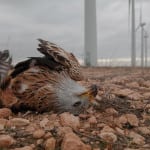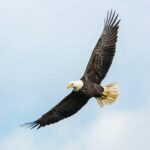A Wyoming court on April 5 sentenced NextEra Energy Resources affiliate ESI Energy to five years of probation and fined the wind power developer more than $8 million for three counts of violating the Migratory Bird Treaty Act (MBTA). The violations include alleged failures to apply for “eagle take permits” (ETPs) at facilities in Wyoming and New Mexico, where turbine-related eagle deaths were documented.
The Department of Justice (DOJ) on Tuesday said the wind generator acknowledged the documented deaths of golden eagles due to “blunt force trauma from being struck by a wind turbine blade” at three facilities in Wyoming and New Mexico. These include ESI’s three-phase 533-MW Cedar Springs wind farm in Wyoming, which went online in 2020; the 325-MW Roundhouse Wind Energy Center facility, which is also in Wyoming and began fully operating in June 2020; and the 50-MW Casa Mesa facility, which FPL Energy New Mexico Wind has operated in De Baca and Quay Counties, New Mexico, since 2003.
ESI also acknowledged “that at least 150 bald and golden eagles have died in total since 2012, across 50 of its 154 wind energy facilities,” the DOJ said. At least 136 of those deaths “have been affirmatively determined to be attributable to the eagle being struck by a wind turbine blade,” it said.
Court documents allege that the U.S. Fish and Wildlife Service (FWS) urged ESI not to build Cedar Springs, citing consultant calculations that suggested 67 collision mortalities of bald and golden eagles could occur if the facility was built, owing to an “unusually high number of occupied golden eagle nests.” The DOJ alleged ESI did not heed repeated recommendations to implement seasonal curtailment during daylight hours, as well as recommendations that ESI apply for an ETP. FWS recommendations that ESI obtain ETPs for the Roundhouse and Casa Mesa projects also went unheeded, documents suggest.
The court in Cheyenne sentenced ESI pursuant to a plea agreement to a fine of $1,861,600, as well as restitution in the amount of $6,210,991, and a five-year period of probation during which it must follow an Eagle Management Plan (EMP). The court-mandated EMP will require investing up to $27 million in measures intended to minimize additional eagle deaths and injuries. The plan also notably requires “payment of compensatory mitigation” for future eagle deaths and injuries of $29,623 per bald eagle or golden eagle. Over the next three years, ESI must also apply for ETPs for “any unavoidable take of eagles at each of 50 of its facilities where take is documented or, in the case of four facilities not yet operational, predicted,” the DOJ said.
At Issue: Incidental Eagle Take Permits
The DOJ said the case was investigated by the U.S. Fish and Wildlife Service Office of Law Enforcement. FWS, which works to conserve, protect, and enhance fish, wildlife, plants, and their habitats, is tasked with implementing statutes including the Endangered Species Act, MBTA, and the Bald and Golden Eagle Protection Act. In 2009, the FWS promulgated a final rule covering two permit rules that specifically authorize the limited incidental (or “non-purposeful”) take (including killing or wounding) of bald and golden eagles—essentially authorizing individuals, companies, government agencies (including tribal governments), and other organizations “to disturb or otherwise take eagles in the course of conducting lawful activities such as operating utilities and airports.”
The rule was revised in 2016 to lengthen the maximum permit tenure from five years to 30 years and require specific methods for pre-construction, eagle surveys, and fatality modeling for wind facilities, which FWS said is “the industry with the largest demand for long-term, incidental take eagle permits.” However, FWS continues to refine the rule. In September 2021, it published an Advance Notice of Proposed Rulemaking to solicit public input and feedback on potential approaches to improve permitting of incidental take of eagles. In addition, the FWS has issued Land-Based Wind Energy Guidelines that align with the agency’s Eagle Conservation Plan (ECP) Guidance.
“If eagles are identified as a potential risk at a project site, developers are strongly encouraged to refer to the ECP Guidance. The ECP Guidance describes specific actions that are recommended to comply with the regulatory requirements in the Bald and Golden Eagle Protection Act for an eagle take permit, as described in 50 CFR 22.26 and 22.27,” the agency suggests.
But though bald and golden eagles are also protected under the Bald and Golden Eagle Protection Act, according to court documents, the government accepted ESI’s guilty plea to only MBTA counts “due in large part to ESI’s agreement to apply for permits at 50 facilities and its prior efforts to minimize and mitigate for eagle fatalities.”
However, ESI’s and its affiliated companies’ actions in Wyoming and New Mexico “were taken under an admitted nationwide posture and alleged corporate policy of not applying for ETPs,” the DOJ alleged. “ESI and its affiliates deliberately elected not to apply for or obtain any ETP intended to ensure the preservation of bald and golden eagles, and instead chose to construct and operate facilities it knew would take eagles, and in fact took eagles, without any permits authorizing that take,” it said.
“Because ESI did not seek any ETPs, it avoided any immediate federal obligation to avoid and minimize eagle take to the maximum degree practicable and to pay for compensatory mitigation for the eagle deaths,” the DOJ said. As significantly, the DOJ suggested that ESI benefited by sidestepping ETPs while other wind facilities paid mitigation for eagle takings, including altering proposed operations. “ESI, by not doing these things, gained a competitive advantage relative to those wind energy companies,” the DOJ said.
Finally, the DOJ suggested ESI began commercial operations at the new facilities “on a schedule intended to meet, among other things, power purchase agreement commitments and qualifying deadlines for particular tax credit rates for renewable energy, and with production amounts not impacted by avoidance and minimization measures that might have been required under an eagle take permit.”
ESI also reaped federal production tax credits for generating electricity from wind power at facilities that it operated, “knowing that multiple eagles would be killed and wounded without legal authorization, and without, in most instances, paying restitution or compensatory mitigation,” the DOJ said.
NextEra Entered Plea Agreement Voluntarily, Though with Concerns
But in a statement on Tuesday, NextEra Energy Resources President and CEO and NextEra Energy Partners President Rebecca Kujawa underscored that ESI Energy “voluntarily” entered into the plea agreement with the DOJ related to what she stressed were “accidental” fatalities. “The most expedient solution was to resolve this dispute and focus our attention on continuing to develop, build, and operate emissions-free wind energy centers for a lower carbon America built by good-paying American jobs,” she said.
Still, she emphasized: “The MBTA is a 1918 statute that prohibits individuals and entities from pursuing, hunting, shooting, wounding, killing, trapping, capturing, or collecting most U.S. birds.” NextEra Energy Resources has “always maintained, and continues to believe, notwithstanding ESI’s plea, that this statute was only intended to cover intentional behavior, like hunting and poaching of migratory birds. As recently as last year, the federal government had adopted regulations that codified that accidental collisions did not violate the MBTA,” she said.
Kujawa also strongly underscored problems with the government’s enforcement policy. “We disagree with the government’s underlying enforcement policy, which under most circumstances makes building and operating a wind farm into which certain birds may accidentally fly a violation of the Migratory Bird Treaty Act—even when the wind farm was developed and sited in a way that sought to avoid avian wildlife collisions,” she said. “The reality is building any structure, driving any vehicle, or flying any airplane carries with it a possibility that accidental eagle and other bird collisions may occur as a result of that activity.”
Kujawa said the enforcement policy has unjust implications. “Unfortunately, the federal government, at odds with many states and a number of federal court decisions, has sought to criminalize unavoidable accidents related to collisions of birds into wind turbines while at the same time failing to address other activities that result in far greater numbers of accidental eagle and other bird mortalities.”
NextEra, one of the world’s largest producers of renewable energy, noted it has over the past two decades invested more than $150 million across the U.S. to support “avian impact mitigation efforts, including taking actions to mitigate avian interaction with our poles, wires and energy generation facilities.” Kujawa said NextEra “voluntarily does more than any other industry in seeking to minimize interactions with avian wildlife.”Among the company’s notable recent activities is the removal of older-generation wind turbines at the Altamont Pass Wind Resource Area in California, and their replacement with fewer, “thoughtfully-sited” repowered turbines that are “more avian friendly.”
According to Kujawa, ESI agreed that a number of NextEra Energy Resources’ and NextEra Energy Partners’ wind facilities will apply for ETPs under the Bald and Golden Eagle Protection Act. However, she noted, “We believe that, like the MBTA, this law does not require a permit to cover unintentional collisions that occur when eagles fly into properly developed wind energy facilities.”
However, “NextEra Energy Resources’ goal has always been, and remains, to develop our projects in ways that will not damage wildlife populations, including eagle populations, and we hope that our resources committed as part of this resolution will be devoted to optimizing eagle conservation,” she said.
Technology Solutions Exist to Mitigate Wind’s Impact on Wildlife
FWS has acknowledged multiple causes for population declines of the 1,093 species of birds protected under the Migratory Bird Treaty Act. Citing figures last updated in 2017, the FWS says most natural and human-caused mortality impacts are caused by landscape alterations, including building-glass collisions and vehicle collisions. FWS also notes landscape alterations resulting from a changing climate are exacerbating losses—which is why it supports wind energy as a decarbonizing solution. “While indirect, slowing climate change through renewable energy can have long-term beneficial impacts to migratory birds by giving habitats and species time to adapt, thus aiding in their conservation,” it says.
Environmental groups, which fiercely advocate for renewable energy as a replacement for fossil-fueled power, support the FWS’s position. But according to Mike Parr, president of American Bird Conservancy (ABC), the ESI case highlights the importance of proper siting, as well as corporate accountability. The nonprofit that is dedicated to conserving birds and their habitats opposes siting wind projects in major bird migration routes or stopover sites, which it says can threaten huge numbers of birds. ABC has provided a wind risk assessment map to help identify these places.
“Renewable energy is essential in the fight against climate change. At the same time, steps must be taken to minimize harm to birds,” said Parr said in a statement to POWER on April 7. “What we’re seeing, in this case, is much-needed accountability for avoidable harm to birds by industry, stemming from the company’s failure to follow the law,” Parr added. “Unfortunately, the company seems to want to blame the laws and the birds for its violations. Blaming the birds is like directing cars to drive on the sidewalk and then blaming pedestrians for being run over. It is well-known that if you put turbines in eagle habitat, there will be fatalities.”
But as more wind facilities come online, their effects on wildlife may undeniably affect songbirds, raptors, other birds, and bats, as Carol Ho, senior director at E3 Consulting noted in a January-published POWER article. Ho suggested technology may offer solutions.
“The use of radar to detect approaching birds is tried and true. It has been used for more than 10 years on wind farms and has been largely voluntary,” she said. Newer technologies include bird deterrents like DTBird, a system composed of daylight cameras and, if needed, thermal ones that can be strapped on the lower part of monopole towers and the nacelle, aimed toward the blade-swept area. DTBird is currently in the second-phase of a validation program under the Energy Department and American Wind and Wildlife Institute’s “Wind Energy-Eagle Impact Minimization Technologies and Field Testing Opportunities” program. Another new technology called Identiflight uses artificial intelligence and cameras installed on top of designated towers to identify bird species and curtail turbines as needed, Ho noted.
—Sonal Patel is a POWER senior associate editor (@sonalcpatel, @POWERmagazine).










